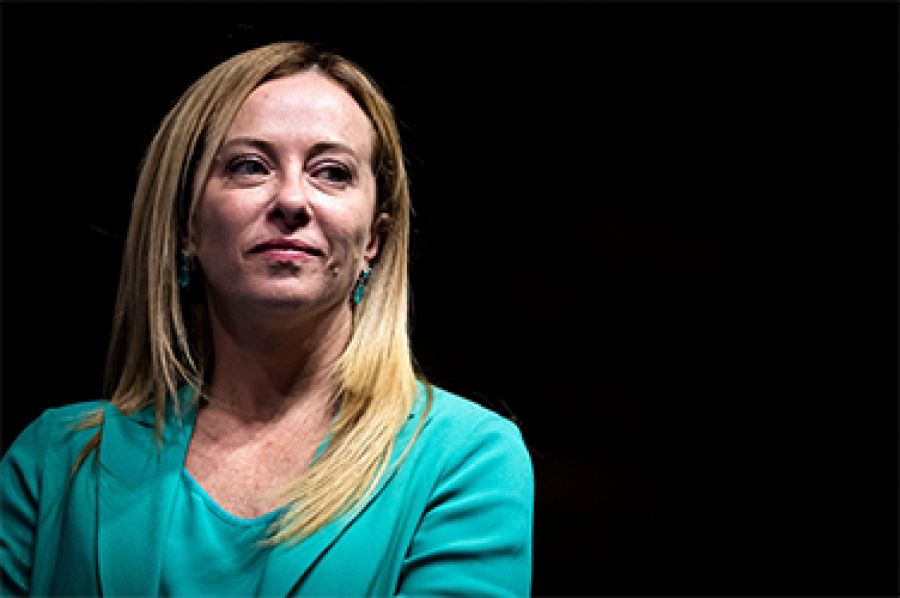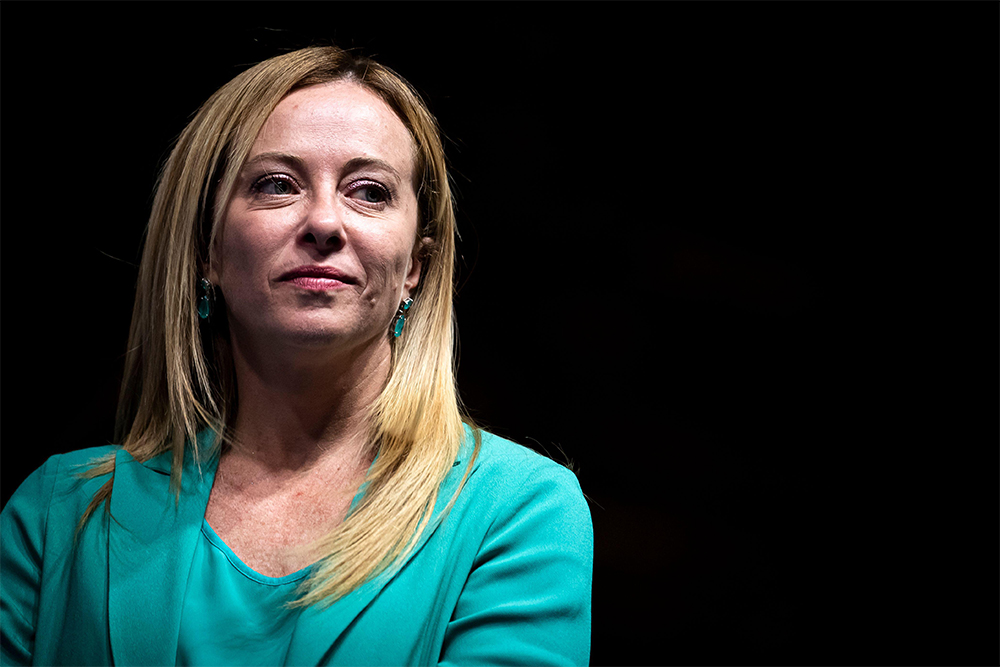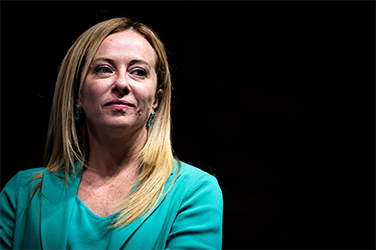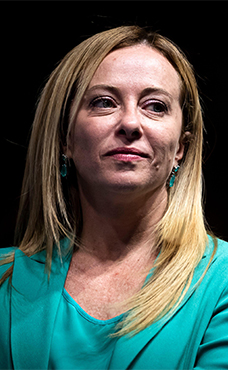
- Free Article: No
- Contents Category: Commentary
- Custom Article Title: Under the beach umbrellas: Italy’s fragile political system’s new test
- Review Article: Yes
- Article Title: Under the beach umbrellas
- Article Subtitle: Italy’s fragile political system’s new test
- Online Only: No
- Custom Highlight Text:
In 1994, Italian photographer Massimo Vitali, seeking to understand the Italy which had swept Silvio Berlusconi’s Forza Italia (FI) comprehensively into power, took his camera to the beach at Marina di Pietrasanta ‘to see who the Italians were … [and] to understand their attitudes … at that precise moment in history’. In 2022, Italian politics returns to the beaches for a campagna balneare (a seaside campaign) conducted in a summer atmosphere of crisis when most Italians are taking their annual vacation.
- Article Hero Image (920px wide):

- Article Hero Image Caption: Giorgia Meloni, leader of Italian far-right party Fratelli d'Italia (photograph by Nicolò Campo/Alamy)
- Alt Tag (Article Hero Image): Giorgia Meloni, leader of Italian far-right party Fratelli d'Italia (photograph by Nicolò Campo/Alamy)
- Featured Image (400px * 250px):

- Alt Tag (Featured Image): 'Under the beach umbrellas: Italy’s fragile political system’s new test' by Claudio Bozzi
The M5S’s actions were absurd and dangerous: it voted against the government of which it formed a majority (and therefore against itself) with no casus belli – leaving, in commedia dell’arte terms, un palazzo confuse, which the right clinically exploited. While the media believed that Berlusconi and FI would restrain Matteo Salvini’s (Lega) impulse to force the crisis, Berlusconi instead did as he always does: he supported the direction in which the forces were already leaning.
The Draghi government, which came to power in February 2021, had always worked in a climate of immanent crisis, only ever sustaining the minimal support required to govern, while centre–right parties sought to destabilise it one issue at a time: with respect, for example, to Ukraine, constitutional reform, justice system reforms, citizenship for migrants, and assisted dying laws.
The election is the strangest imaginable: one in which the parties that had supported and worked with Draghi, and governed together to confront major issues such as energy security and tax reforms, are now at odds and have placed themselves under the leadership of that government’s staunchest opponent, Giorgia Meloni of Fratelli d’Italia (FdI).
The election represents a disquieting moment given that those who caused the fall of the Draghi government avow admiration for and friendship with Vladimir Putin (Salvini and Berlusconi) or have resisted sending arms to Ukraine (M5S). The right is likely to impede or reverse the pro-Atlanticist and pro-Nato policies of the Draghi government. The FdI, Lega, and FI are also part of a staunchly anti-EU alliance of European sovereignist parties which includes President Orbán of Hungary, Marine Le Pen in France, and Spain’s far-right VOX party.
After recent administrative elections, the respected leader of the Azione party, Carlo Calenda, announced a normalisation of Italian politics around three poles: the right (represented by the Lega, FI, and FdI), the left (the Partito Democratico [PD] and M5S), and the centre (Azione). The question in this election is how extensive the centre is, and whether the conditions exist to create a significant centre left.
While Italians refer to a centre right and centre left as if they were governing parties and governing systems, they do not exist in government. The search for a unified left has haunted Italian politics since the faltering attempts of Romano Prodi’s Ulivo coalition in the mid-1990s. Prodi was a unifying figure around which a centre left alternative government could be created. As ‘a social progressive who had met a payroll’, he represented the middle way between free market capitalism and the failings of social democratic welfarism.
The frequent calls for the left to ‘do a Bad Godesberg’ (the idiomatic phrase in European socialism for undergoing a fundamental alteration in its core doctrinal values to find a third way) and to remake itself as the voice of Italian liberalism have never been answered. The fear remains that a democratic party would be defeated because it would be easy for the right to portray it as a communist takeover of the centre; and arguably opposition is stronger when conducted as a common effort by distinct parties and movements.
Enrico Berlinguer, the popular leader of the Italian Communist Party (PCI), said in the 1970s that ‘Italy cannot be governed by fifty-one per cent of the vote’. There are no parties of the masses, and Italian electoral laws – a mixture of first past the post and proportional representation – have given rise to the concept of the campo largo – broad alliances of heterogeneous coalitions. In a Hobbesian state of nature where all are at war with all, Berlusconi’s exhortation to the right – ‘We must remain united for convenience’ – is transparently true.
The current election campaign is being organised around a number of pacts. While traditionally associated with the politics of the right, the opportunistic pursuit of electoral advantage is not entirely uncharacteristic of the left. The PD and Azione initially entered a patto elettorale (a title redolent of pragmatism) for the purpose of shoring up the centre. It was disbanded within a week when Calenda announced on television his decision not to proceed with it. Among the reasons he gave was that he had found in the PD no ‘amore a fare politica’. Calenda has since entered an alliance with former Prime Minister Matteo Renzi’s Italia viva party, whose appetite for ‘politics with a capital P’ is well known.
Under the leadership of Enrico Letta, the PD has emerged as the second party nationally (closely behind the FdI), and the most supported party in the recent communal elections. Rather than garnering votes from the disaffected margins of the right, Letta is intent on enlarging the PD’s electoral base and recovering the ‘connessione sentimentale’ by which it had built its base amongst the disenfranchised. In doing so he must overcome the perception that Italian socialism is a movement of eminent professors and élite professionals – the alta borghesia – and the problem that while it has a wealth of institutional expertise, it has lacked a figure able to appeal to the base of the working class and small business in the language of the everyday.
Letta is constructing a position distinctly to the left of the centre – an alternative political project to the sovereignist and neo-liberal one of the Italian right, and a continuation of the work of Berlinguer of ‘putting socialism in the West’. The question is whether the PD will join forces to achieve its political objectives or deny the right its political objectives, or seek to fight this campaign on its own. If the PD is to enter alliances, it will be on the basis of a political program rather than ideological sympathies. Political calculus suggests that a united right is more likely to win the election. However, given that the crisis is identified with the right, the PD may have an opportunity to at least take control of the agenda.
The PD is hampered by being unable to forge a partnership with natural alliance partners such as the M5S. Very few parties have surrendered political capital with such profligacy as the M5S. From a thirty-three per cent share of the vote in 2018, it has since lost 176 parliamentarians and eight million of the twelve million votes it won. The party is being punished for its chaotic and self-contradictory performance, lurching between leftist opposition and irresponsible populism, unable to resolve its own identity. It appeared to provoke the government crisis in a desperate and miscalculated attempt at relevance and visibility as it collapsed in the polls.
Its leader, Giuseppe Conte, is seen as il quasismo (the almost man) – not quite standing for anything. Although he entered the M5S as a moderate, having split with Salvini over the latter’s extreme positions, his polemics on Ukraine have been radical and incoherent. He stated that the M5S does not believe that Ukraine needs arms but that Europe needs peace – an evasion of the question of Italy’s military support under Draghi, whom he has called a guerrafondaio (warmonger) – without offering concrete alternatives.
The centre right had lost its tolerance of Draghi because of his interference in the core business of political parties, and had been in campaign mode for some time, when the government dissolved. To them, reforming the justice system and undertaking geopolitical diplomacy was one thing, but interfering with the regime of property taxes was a serious matter. The centre right’s progress as a cohesive alliance is likely to be tested, given the recomposition of its constituents, and the potential antagonism among its leading figures. The FdI is now the leading party, and Giorgia Meloni – who brought the party from 1.7 per cent to a twenty-four per cent share, and a lead, in the polls within nine years – is likely to become Italy’s first female prime minister. While the Lega and FI have been reduced to junior partners, the power of Salvini and Berlusconi means that confusion persists as to the shape the alliance will take.
While the FdI presents itself as a modern party of the right, a fascist shadow hangs over it. Its shield incorporates the image of the flame which lights the crypt of Benito Mussolini at Predappio. After denying that the flame carried those overtones because historical transformation had denuded it of such significance, Meloni declared publicly that it would be removed one month before the election. To date it has not. Other zones of contiguity between the party and extreme movements, such as its student arm, which embraces white supremacy and participates in neo-fascist music festivals, also remain.
The Lega, while it is no longer the leading party in the country (plummeting from thirty-four per cent in 2018 to fifteen per cent) remains highly organised and disciplined. The issues have outgrown Salvini’s simplistic responses to the nation’s problems. Formerly, everything from employment to violence could be solved by stopping migration. Asked recently what concrete proposals the Lega has to reform property taxes, Salvini said ‘Peace’ – as if the end of the supply of arms to Ukraine would resolve all of Italy’s economic problems and save Italian jobs. The party’s tax policy (a flat fifteen per cent rate) has subsequently been dubbed a ‘Fiscal Peace’.
In the groundhog day of Italian public life, Berlusconi has once again entered the arena of a national election, proposing the FI as the true Centre. Earlier indications that the party’s moderates may have assumed greater prominence have been resisted by its leadership. Mariastella Gelmini, who cried out ‘Questa non e ancora tuo partito’ (This is no longer your party) to Berlusconi at the party conference, has since been largely silenced. Simona Malprezzi, who spoke favourably of a campo largo, and Elio Vito, who supported Draghi’s policies on Ukraine, are lone voices.
As ever, Berlusconi counts on the cultural synthesis between himself and the Italian people. The party convention in Naples bore all the hallmarks of previous Berlusconi spectacles, but was also haunted by the spectre of Ruby Ter, the sex scandal in which Berlusconi has been embroiled for years, and which involves him persistently in personal litigation while not, it seems, diminishing his political viability.
The most likely election outcome is that the centre right will win the Camera with an outright majority, and that it may win the Senate, but with only a slim majority of four to five seats. An election analysis which removes the M5S from the reckoning even more overwhelmingly favours the centre right, delivering an absolute majority (two-thirds of the Camera), with which it can rewrite the constitution without a mediating referendum, carrying out its intended reform of the structure of the presidency. As recent events, including the trigger for this election, have shown, the role of a president as crisis broker with the power to dissolve parliament and nominate the prime minister remains relevant.
Recent analysis suggests that Italy’s is a thoroughly demotivated electorate. A summer election sotto l’ombrellone (under the beach umbrellas) will be another test of Italy’s fragile democratic system. A lack of electoral involvement is a resource of populism, and means that political analysis can only be conducted with great sobriety. As is frequently said in Italian politics ‘vediamo domani’ (‘we will see tomorrow’).
This article is generously supported by the Judith Neilson Institute for Journalism and Ideas.



Comments powered by CComment